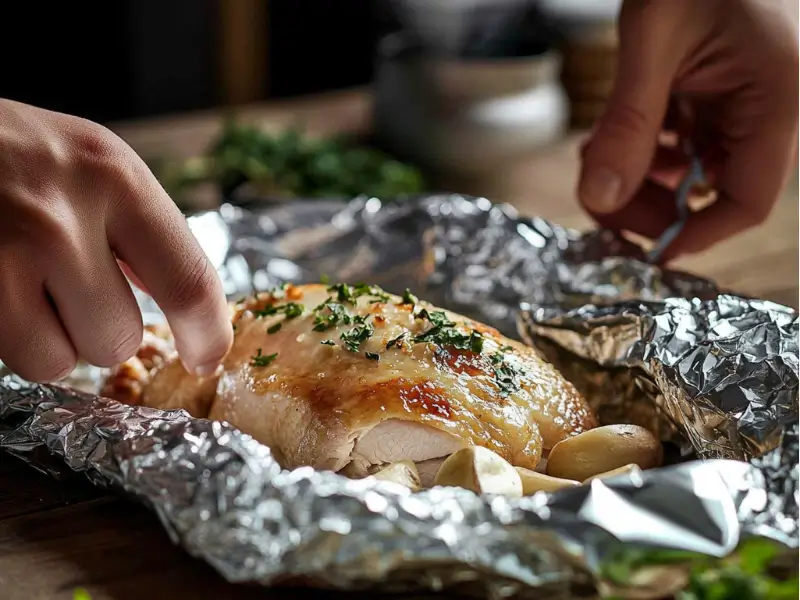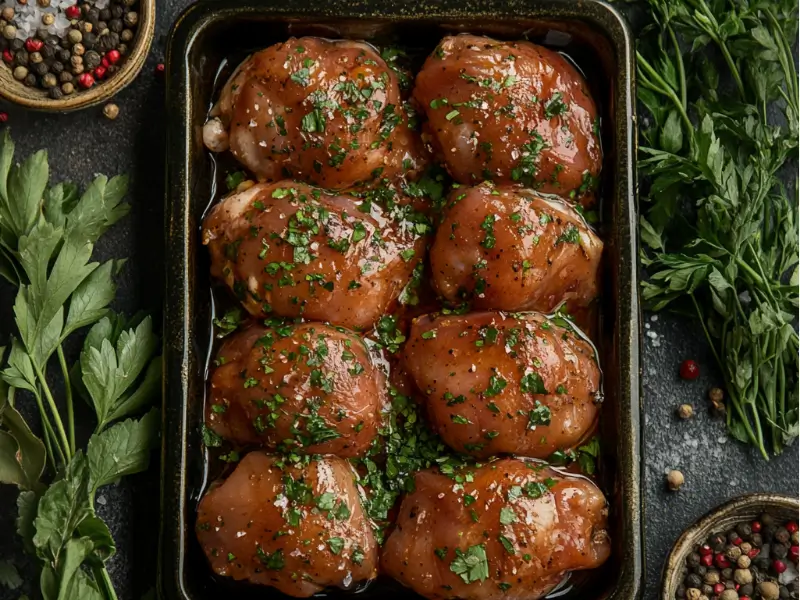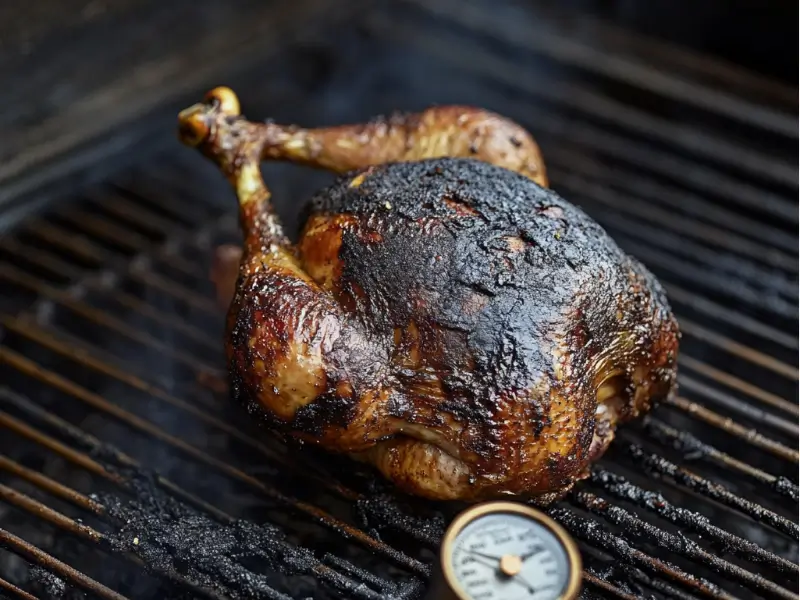Smoking chicken is a culinary art that enhances the natural flavors of the meat while imparting a distinct smoky aroma. A common question for barbecue enthusiasts is, “Do you wrap chicken when smoking?” The debate between wrapping and not wrapping is longstanding. In this guide, we’ll explore the benefits and drawbacks of wrapping chicken, methods to maintain moisture, tips for perfect smoking, and answer your top FAQs.
Table of Contents
Understanding the Basics of Smoking Chicken
What Does Smoking Chicken Entail?
Smoking chicken involves slow-cooking the meat over indirect heat while infusing it with flavorful wood smoke. This process enhances its taste and creates a tender texture. Smoking chicken requires attention to detail, including temperature management and timing, to avoid overcooking or drying out the meat.
How Wrapping Affects the Smoking Process
Wrapping is a technique used to control how the meat cooks by trapping heat and moisture. When chicken is wrapped during smoking, it tends to cook faster, retain moisture, and develop a soft texture. However, wrapping can reduce the crispy skin texture that many love.
Learn more about smoking techniques in our Ultimate BBQ Guide.
Do You Wrap Chicken When Smoking?
The Pros of Wrapping Chicken While Smoking
Wrapping chicken during smoking has several advantages that appeal to many barbecue enthusiasts:
- Retains Moisture: Wrapping traps steam and juices, preventing the chicken from drying out during the long smoking process. This results in tender, juicy meat.
- Speeds Up Cooking: The foil or butcher paper acts as an insulator, accelerating the cooking process by maintaining heat around the chicken.
- Enhances Flavor Penetration: When combined with marinades or sauces, wrapping helps infuse the flavors deeply into the meat.
- Prevents Over-smoking: For those who prefer a milder smoky flavor, wrapping minimizes direct exposure to smoke, avoiding an overly smoky taste.
The Cons of Wrapping Chicken While Smoking
While wrapping has its benefits, it also comes with drawbacks:
- Soft Skin Texture: Wrapping creates a moist environment, which can lead to soft or rubbery skin instead of the desired crispy texture.
- Reduced Smoke Penetration: The foil or paper can block some of the smoke, resulting in less smoky flavor.
- Extra Steps: Wrapping adds an additional step to the process, which some may find inconvenient or unnecessary for smaller cuts of chicken.
When Should You Wrap?
Wrapping is often recommended for larger chicken cuts like whole chickens or bone-in thighs, especially during the final stages of smoking. This technique, known as the “Texas Crutch,” is commonly used to retain moisture and ensure even cooking.
Looking for inspiration? Try our Smoked Chicken Recipe for step-by-step instructions.
Methods for Wrapping Chicken While Smoking

Using Aluminum Foil for Smoking Chicken
Aluminum foil is one of the most popular choices for wrapping chicken during smoking. Here’s why:
- Heat Retention: Foil traps heat effectively, cooking the chicken faster while retaining its natural juices.
- Customizable Wrapping: You can wrap the chicken tightly or loosely, depending on how much moisture and smoke you want to retain.
How to Use Foil for Smoking Chicken:
- Smoke the chicken unwrapped for the first 2-3 hours to allow it to absorb the smoky flavor.
- Wrap the chicken tightly in foil during the last 1-2 hours to lock in moisture.
- Optionally, add a small amount of marinade or butter inside the foil for extra flavor.
Butcher Paper as an Alternative Wrapping Method
Butcher paper, especially pink butcher paper, is another effective wrapping option. Unlike foil, butcher paper is porous, allowing some smoke to penetrate while still retaining moisture.
Advantages of Using Butcher Paper:
- Maintains Texture: Butcher paper helps retain the crispy exterior better than foil.
- Improves Smoke Flavor: Since it allows some smoke to pass through, the chicken develops a richer smoky flavor.
How to Use Butcher Paper for Smoking Chicken:
- Start by smoking the chicken unwrapped for 2-3 hours.
- Wrap it in butcher paper for the final 1-2 hours to maintain moisture while preserving the smoky aroma.
- Ensure the wrapping is tight but leaves room for air circulation.
Discover other great ideas like BBQ Marinade Tips to elevate your smoked chicken recipes.
Smoking Chicken Without Wrapping
Advantages of Smoking Chicken Unwrapped
Smoking chicken without wrapping allows you to achieve the following benefits:
- Crispier Skin: One of the biggest advantages is that the skin develops a crispy, golden-brown texture, which is difficult to achieve when wrapped.
- Intense Smoky Flavor: Unwrapped chicken is exposed to smoke throughout the entire cooking process, resulting in a bolder, more pronounced smoky flavor.
- Simpler Process: Skipping the wrapping step makes the smoking process straightforward and less time-consuming.
How to Avoid Dry Chicken When Smoking Without Wrapping
Smoking chicken without wrapping can lead to dryness if precautions aren’t taken. Follow these tips to keep your chicken moist:
- Use a Water Pan: Place a pan of water inside the smoker to maintain humidity levels and prevent the chicken from drying out.
- Monitor Temperature: Keep the smoker temperature between 225°F and 250°F to ensure slow, even cooking without drying the meat.
- Brine the Chicken: Brining adds moisture to the chicken, making it less likely to dry out during smoking.
- Baste Regularly: Use a mop sauce or marinade to baste the chicken every 30-60 minutes to lock in moisture and add flavor.
Pro Tip: Smoking chicken unwrapped is ideal for smaller cuts like wings or drumsticks, where the risk of drying out is minimal. However, if you’re smoking a whole chicken, consider partially wrapping during the final stages to balance moisture and texture.
Recipes, check out our Crispy Smoked Chicken Wings recipe.
How to Keep Chicken Moist When Smoking

Brining Your Chicken for Added Juiciness
Brining is one of the best methods to ensure your chicken remains moist and flavorful during smoking. It involves soaking the chicken in a solution of water, salt, and optional flavor-enhancing ingredients like herbs and spices.
Why Brining Works:
- Moisture Retention: Salt in the brine helps the chicken absorb and retain water, keeping it juicy even during long smoking sessions.
- Flavor Infusion: Herbs, garlic, or spices in the brine penetrate the meat, adding depth to the flavor.
Quick Brine Recipe:
- 1 gallon of water
- 1/2 cup of kosher salt
- 1/2 cup of sugar
- Optional: Garlic cloves, peppercorns, and fresh herbs
The Role of Temperature and Timing
Controlling the smoker’s temperature and timing is crucial for maintaining moisture.
- Maintain Low and Slow Heat:
- Keep the smoker temperature between 225°F and 250°F for slow and even cooking. This prevents the chicken from drying out.
- Use a Meat Thermometer:
- The internal temperature of the chicken should reach 165°F in the thickest part to ensure doneness without overcooking.
- Don’t Overcook:
- Overcooking is a common cause of dry chicken. Remove the chicken from the smoker as soon as it hits the target temperature.
Other Moisture-Retaining Tips
- Basting: Use a flavorful basting sauce or butter to coat the chicken periodically during smoking.
- Wrapping: Consider wrapping larger cuts in the final stages to lock in juices.
Looking for inspiration? Try our Ultimate Chicken Brining Guide.
Tips for Perfectly Smoked Chicken
Ideal Wood Chips for Smoking Chicken
The type of wood chips you choose can greatly influence the flavor of your smoked chicken. Here are some top choices:
- Applewood:
- Imparts a sweet, mild flavor that pairs beautifully with chicken.
- Ideal for those who prefer a subtle smoky aroma.
- Hickory:
- Produces a bold, bacon-like flavor.
- Perfect for recipes that require a strong, smoky taste.
- Cherrywood:
- Adds a touch of sweetness with a reddish hue to the chicken.
- Great for presentation and balanced flavor.
- Pecan:
- Provides a nutty, sweet flavor.
- Best for rich and savory chicken recipes.
Pro Tip: Mix wood chips (e.g., apple and cherry) for a unique flavor profile. Soak the chips in water for 30 minutes before smoking to produce steady, flavorful smoke.
The Importance of Resting Your Smoked Chicken
Resting smoked chicken after cooking is a crucial yet often overlooked step.
Why Resting Matters:
- Redistribution of Juices: Resting allows the meat to reabsorb its juices, ensuring every bite is moist and flavorful.
- Easier to Carve: Resting makes the meat firmer and easier to slice cleanly.
How Long to Rest:
Let the chicken rest for 10-15 minutes, tented with aluminum foil, to retain warmth without trapping steam.
Additional Tips for Smoking Perfection
- Preheat the Smoker: Always preheat your smoker to the desired temperature before adding the chicken.
- Use a Water Pan: Maintain humidity by placing a water pan inside the smoker. You can even add herbs or citrus to the water for an aromatic boost.
- Flip and Rotate: For even cooking, flip and rotate the chicken periodically, especially when smoking multiple pieces.
Looking for inspiration? Try our Perfect Chicken Recipe.
Common Mistakes to Avoid When Smoking Chicken

Over-smoking and Its Impact on Flavor
Adding too much smoke to chicken can overpower its natural flavor and make it taste bitter. This is a common mistake, especially for beginners.
How to Avoid Over-smoking:
- Use a moderate amount of wood chips—about one handful every hour is usually sufficient.
- Avoid strong woods like mesquite for chicken, as they can be too intense.
- Monitor the smoker closely to ensure a steady flow of clean, thin smoke instead of thick, heavy smoke.
Improper Wrapping Techniques
When wrapping chicken, improper techniques can lead to uneven cooking or loss of flavor.
Common Wrapping Errors:
- Wrapping Too Early: Wrapping chicken too soon prevents it from absorbing enough smoky flavor.
- Wrapping Too Tightly: A tight wrap can trap too much steam, resulting in soggy skin.
- Skipping the Resting Step: Removing the wrap too late can prevent the chicken from cooling slightly and retaining its juices.
Fix It: Only wrap chicken during the final stages of smoking and allow it to rest for a few minutes after unwrapping.
Neglecting the Temperature
One of the biggest mistakes when smoking chicken is relying solely on cooking time rather than checking the internal temperature.
How to Get It Right:
- Always use a meat thermometer to monitor the internal temperature. Chicken is done when it reaches 165°F in the thickest part.
- Avoid opening the smoker too often, as this releases heat and prolongs cooking.
Skipping Preparation Steps
Preparation is key to successful smoking. Failing to brine, season, or dry the chicken properly can lead to bland or dry results.
Preparation Essentials:
- Brine the chicken for added moisture.
- Season generously with spices or rubs.
- Pat the chicken dry to help the skin crisp during smoking.
For recipess, check out our Common BBQ Mistakes Guide.
FAQs on Smoking Chicken
Can You Smoke Meat Without Wrapping It?
Yes, you can smoke meat without wrapping it. Smoking without wrapping allows the meat to absorb more smoke and develop a crispy exterior. However, it may take longer to cook, and there’s a higher chance of the meat drying out if not monitored properly. Use a water pan and baste regularly to retain moisture when smoking unwrapped.
What Is the Trick to Smoking Chicken?
The trick to smoking chicken lies in preparation, temperature control, and timing. Here are some key tips:
Brine or Marinate: Pre-soak your chicken to lock in moisture and add flavor.
Keep the Smoker at a Steady Temperature: Maintain a range between 225°F and 250°F for slow, even cooking.
Use the Right Wood Chips: Lighter woods like applewood or cherrywood are ideal for chicken.
Rest Before Serving: Let the chicken rest for 10-15 minutes to redistribute juices.
How Do You Keep Chicken Moist When Smoking?
Keeping chicken moist during smoking requires a combination of techniques:
Brining: Soak the chicken in a saltwater solution before smoking.
Using a Water Pan: This maintains humidity in the smoker.
Basting or Spritzing: Apply a liquid marinade or spray every 30-60 minutes to prevent dryness.
Should You Wrap Your Meat in Foil When Smoking?
Wrapping meat in foil, also known as the “Texas Crutch,” is optional but useful for certain cuts like chicken. Wrapping helps retain moisture and speed up cooking. However, it can soften the skin and reduce smoke penetration. Use foil during the final stages of cooking for the best results.
Discover more techniques in our Ultimate Recipes Guide.
For recipes, check out our Top Chicken Ideas.
Conclusion: Is Wrapping Necessary?
Smoking chicken is a versatile process, and whether to wrap it or not depends on your preferences and goals. Wrapping chicken during smoking helps retain moisture, speeds up cooking, and enhances flavor infusion, making it a great option for larger cuts or when time is a factor. However, unwrapped chicken delivers a crispier texture and a more intense smoky flavor, ideal for smaller cuts like wings or drumsticks.
To achieve the best results, consider a hybrid approach: start by smoking the chicken unwrapped to build that rich smoky flavor, and then wrap it during the final stages to lock in moisture. Remember, the key to perfect smoked chicken lies in proper preparation, temperature control, and allowing the meat to rest before serving.
Whether you’re a fan of the crispy skin from unwrapped chicken or the tender, juicy meat from wrapped chicken, experimenting with both methods will help you find the perfect balance for your taste.
Don’t miss our Smoked Chicken Masterclass for more tips and tricks!

